#pupal stage
Text

the closer i crop this the hornier it gets
5 notes
·
View notes
Text
Shuu sending Kylie this when they become friends:

#i am sick mentally and physically#lying in my bed like a young caterpillar ready to break forth into the natural world#and my brain is full of gunk too pure for the pupal stages#hence the intense shitposting#gunk#shuu gunk#shuucore#horse
4 notes
·
View notes
Text
creampuff’s evolution went better than expected but it took a HELL of a lot longer than predicted. moral of the cautionary tale: do NOT everstone a pupal stage pokemon. she’s a bit of a runt of a salamence because her growth cycle was thrown off schedule, but she should continue growing even after she’s evolved so we’ll see how that turns out. she’s currently on a medication to help regulate her growth hormones but there won’t be any definite results for a long while. since. you know. she’s a dragon
and yes, she’s happy and healthy right now
1K notes
·
View notes
Text
the lesbians are all entering their pupal stages. big news on the lesbian dating scene every lesbian is currently decaying inside their chrysalis that they might form into a new creature
729 notes
·
View notes
Note
Hello, I'm curious, do all bugs that have a larval stage form a cocoon/crysalis and basicaly melt into a new form like caterpillars do? If not, what is the transformation like?
I'll simplify this, but be aware there are always exceptions.
The majority of insects go through either complete metamorphosis or incomplete metamorphosis.
Moths/butterflies, beetles, and flies, for example, go through complete metamorphosis, so they have a pupal stage - cocoon and chrysalis are just other words for the pupal stage depending on the exact form it takes. The immature/baby forms of these bugs are called larvae. The larvae for these bugs do molt several times to get larger before pupating, but they don't get their wings until they emerge from their pupa, which is their final molt into their adult form. Their reproductive organs won't be fully formed and usable until they're in their adult stage. So for example, a caterpillar will hatch from an egg, then have several molts where it becomes a fatter/bigger caterpillar. Then it molts into a pupa, and then the adult moth emerges from the pupa.
Bugs that go through incomplete metamorphosis gradually change from an immature form to an adult form through a series of molts. The immature/baby forms of these bugs are usually called nymphs. This would include true bugs (cicadas, stink bugs, assassin bugs, etc), cockroaches, mantises, and grasshoppers, among others. As they go through successive molts, they usually start forming little wings, but the wings and reproductive organs won't be fully formed and usable until their final molt into adulthood.

271 notes
·
View notes
Text
Moth of the Week
African Death’s-Head Hawkmoth
Acherontia atropos

The African death's-head hawkmoth is part of the family Sphingidae and is the most widely recognized of the three species of Death’s-Head Hawkmoth. The species was described in 1758 by Carl Linnaeus. Its common name comes from the skull shape on the back of its thorax. It’s binomial name: comes from the river Acheron in Greece, which was believed to lead to the Underworld, and the Greek goddess Atropos respectively.
Description The forewings are black/brown with mottled shades of brown while the hindwings are buff orange with two black/brown stripes that curve with the edge of the hindwing. The head and thorax are the same black/brown color as the forewings interrupted by the brown skull on the back of the thorax. The abdomen is the same buff color as the hindwings with similar stripes of the same color. There is also a single stripe down the center of the abdomen called the “dorsal stripe.”
Average Wingspan: 13 cm (5 in)
Females are large than males with a rounded abdomen tip and larger, thicker antennae
Males have a pointed abdomen tip
Diet and Habitat Larva of this species mainly eat the leaves of potato plants which have alkaloids. The larva accumulate these toxins to become unpalatable to predators. Adults eat the nectar of flowers and stolen honey from the beehives of the Western Honey Bee. They are able to mimic the scent of bees and steal the honey undetected. They use their proboscis, a tube used to drink nectar and honey, to break the honey comb.
Their ranges stretches from the Middle East, as far south as the southern tip of Africa, as far north as southern Great Britain, as far east as India and western Saudi Arabia, and as far west as the Canary Islands and Azores. It is known to move into western Eurasia, but a majority do not survive the winter.
Mating This moth has multiple generations per year. In Africa, the broods are continuous. In the northern range, the larva overwinter in the pupal stage. Eggs are laid singly on the underside of species in mainly Solanaceae but also Physalis, Verbenaceae, Cannabaceae, Oleaceae, Pedaliaceae and others.
Predators This moth can emit a special squeak noise by sucking in air to vibrate a flap in its mouth and throat. The purpose of this squeak is unclear, but the two hypotheses are it is to scare away predators or to mimic the sound of a queen bee makes for the workers to stop moving to easier raid beehives for honey. They are also immune to bee venom and can mimic the scent of bees.
Fun Fact This moth has appeared many times in pop culture as symbols of death and evil:
It appeared in The Hireling Shepherd, Bram Stoker's Dracula, Un Chien Andalou, the promotional marquee posters for The Silence of the Lambs, in the music video to Massive Attack's single, "Butterfly Caught,” and on the American edition's cover of José Saramago's novel Death with Interruptions.
It is mentioned in Susan Hill's Gothic horror novel I'm the King of the Castle and John Keats’s "Ode to Melancholy.”
It is referred to in The Mothman Prophecies.
Finally, the moth is used as a calling card by the serial killer Buffalo Bill. However, in the movie script they are referred to under a different species of death’s-head hawkmoths.
(Source: Wikipedia, Simple English Wikipedia)
#libraryofmoths#animals#bugs#facts#insects#moth#mothoftheweek#lepidoptera#Sphingidae#African death’s-head hawkmoth#Acherontia atropos
161 notes
·
View notes
Note
Is Swadloon a proper pupal-stage pokemon or is it something else? I often see it get compared to other pupal bug pokemon (kakuna, silcoon, metapod) but also the only real similarity I see is its a middle stage bug type, it doesnt really have any sort of cocoon or chrysalis so much as a Big Leaf
swadloon are really interesting! i've been reading up a lot on them for my sewaddle care project haha.
so not every three-stage bug type pokemon is the same. while many of them immediately enter a pupal state, during which their bodies break down in preparation for evolution, sewaddle spends most of its time able to move about and eat. it's only in the last few days leading up to evolution that it closes up its leaves and pupates. we think this is because it makes its pupa entirely out of leaves, which aren't as sturdy and protective as, say, a metapod's chyrsalis.
56 notes
·
View notes
Text
i thought about why the firefly man will created in secondo had his hands clasped together in prayer, and it led me to a new realisation of where exactly i’d seen something like that before -
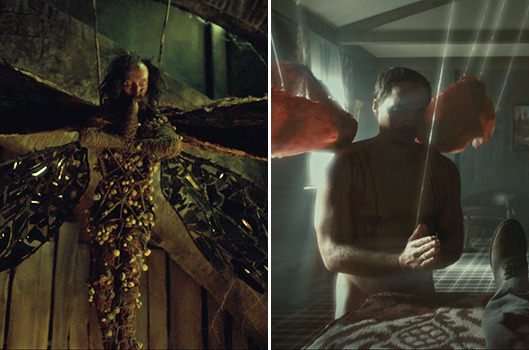
the angels from coquilles. in coquilles, the angel maker thought he could sense evil in people and would kill and turn those people into angels, purifying them in the process.



the prisoner killed mischa and will delivered justice for that crime through chiyoh, and elevated him in the process, just like what the angel maker did to his victims (will would come to be known as the “lamb of god” who takes away your sins in the red dragon arc). another reason why the angel maker created the angels was so they’d watch over him, because he didn’t want to die in his sleep. though will doesn’t sleep under the firefly man, he spiritually died in mizumono and references to him being dead are brought up more than a few times in the first few episodes of season 3. and consider this scene just before will creates the firefly man -

jack is in the norman chapel along with pazzi. jack tells pazzi, who asks him if he’s a believer, “aren’t we all? belief comes with imagination. we also imagine the possibility that we all live on after death. will graham died. he was dead. i was dead. we didn’t imagine that”. before he says this though, he lights a votive candle. votive candles are used as divine offerings to god, and combined with jack’s words about imagining the possibility of life after death, we can see will creating the firefly man as an answer to jack’s prayer, since with this tableau, he literally created life after death.


how did will create life after death? when they first meet, chiyoh tells will the prisoner is only allowed the sound of water like what the unborn hear. the firefly is the last stage of metamorphosis from the pupal form, so the prisoner goes from the unborn stage to the mature adult stage because of will turning him into the firefly. we also see the prisoner eating snails, which as hannibal tells bedelia in contorno, is the fuel which the firefly larvae use to transform themselves into delicate creatures of such beauty.


something chiyoh also says is that will is not allowed to look at the prisoner or speak to him, saying he’s cast aside the social graces afforded to human beings by killing mischa. since chiyoh says that the prisoner is unborn directly after saying this, there is a direct link between the prisoner not being looked at, or “seen”, and his being unborn.
“belief comes with imagination”, and what is will known for? his imagination, his empathy. it’s will’s empathy which allows for the possibility of life after death. will grants his gift of being seen to the prisoner through his empathy and gives him a rebirth, just like he did with randall tier who wanted to be seen and who had his becoming when he was turned into a beast and displayed in the museum. the prisoner lived his whole life in a dark, damp prison, so with his wings and with the lights reflecting off of him and around him, will sets him free and gives him what he couldn’t have in life in death.
not only is the prisoner reborn, will is as well. will has just created the imago, the flying insect which is the final stage of transformation which he and hannibal discussed in mizumono. and think of the journey will undergoes to get to this point, it occurs entirely through water -

“he’s only allowed the sound of water. it’s what the unborn hear”.
we also see hannibal’s kitchen being flooded with blood in primavera, and a close up of will’s guts in aperitivo, which is compared to a womb in the script, while hannibal embraces him and then stabs him.


will sinks in this bloody water in primavera, and walks on its surface to get to lecter castle in secondo (walking backwards because he’s going backwards in time like when he lets the pendulum swing and recreates a crime scene - he’s recreating mischa’s crime scene, going back to when the teacup first shattered so that he can understand hannibal).

what about jack and his belief that he’s dead though? it’s in aperitivo that jack lets go of bella and puts her to sleep permanently. bella had told him before that he’s not going to go into the ground with her, so we can see this as jack beginning to accept that he belongs to the land of the living. in contorno, he tells hannibal that after he’s gone, he’ll feel alive, before pushing him out a window. coming back to the angel maker, the angel maker had cancer and would make angels to watch over him so that he doesn’t die of cancer in his sleep. bella directly compares hannibal to a cancer within jack, saying he can cut out what’s killing him. was jack as successful as the angel maker or bella in cutting out his cancer (read: not successful not all)? the evidence suggests so, since in the red dragon arc he’s again back to his old ways and back to his old dynamic with will and hannibal, making use of them to solve cases in an effort to save lives.
#hannibal#nbc hannibal#hannibal meta#will graham#jack crawford#i am so not confident about that last part of the post but w/e#long post
178 notes
·
View notes
Text
The Common Green Lacewing: these tiny insects pupate within loosely-woven cocoons that measure just 3-6mm (about 1/8 to 1/4 inch) in diameter

The lacewing will spend about 5 days maturing within its cacoon, before it cuts an opening in the top and emerges as a fully-developed adult.

The larvae of the green lacewing (family Chrysopidae) are also known as "aphid lions," due to their skill/appetite when it comes to hunting aphids. They're widely used in agricultural contexts to help eradicate pests, because they are voracious predators that also commonly prey upon caterpillars, leafhoppers, planthoppers, thrips, spiders, mites, and insect eggs.
As it nears the end of its larval stage, a lacewing will spin a small cacoon out of silk and then tuck itself inside, allowing the pupal phase to begin; its tiny green body is often partially visible through the thin, loosely-woven walls of the cacoon.
These breathtaking photos of a lacewing climbing out of its cacoon were taken by a Danish photographer named Frederik Leck Fischer.
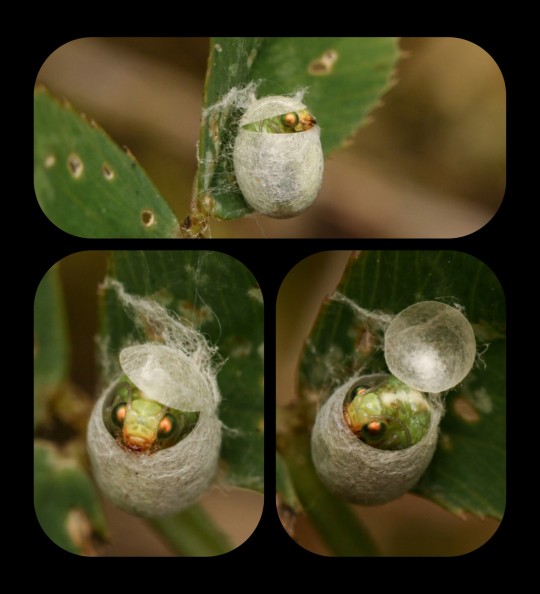
When a lacewing first emerges from a cacoon, its wings are still compactly folded down against its body; the wings then gradually begin to expand until they have reached their full size, which usually takes about an hour or two.
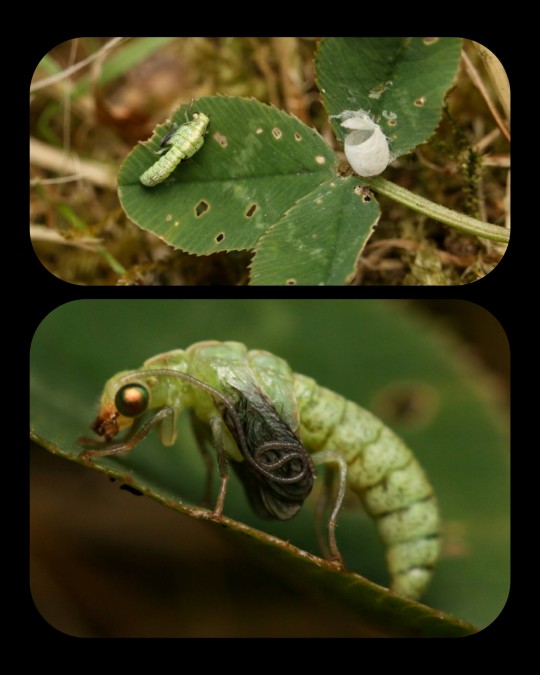
Fischer's photographs provide an excellent account of this entire process.
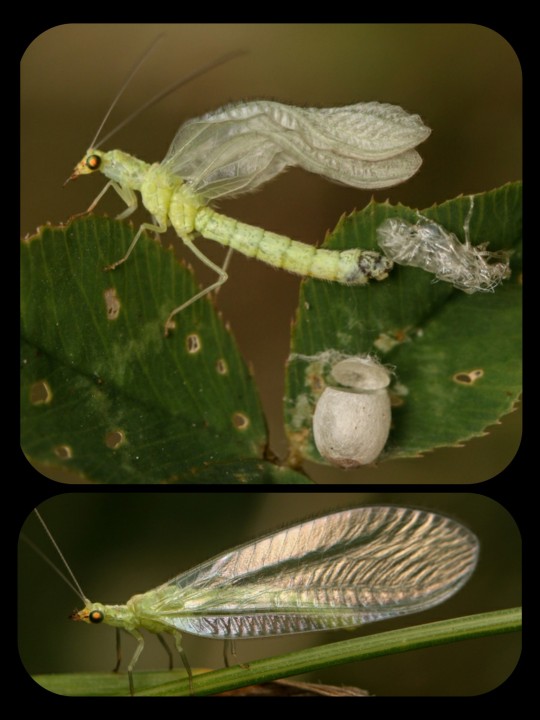
Here are just a few other images of the common green lacewing:

Sources & More Info
University of California's Integrated Pest Management Program: The Green Lacewing
Texas A&M's Field Guide to the Insects of Texas: Green Lacewings
Washington State University: Lacewings
Tennessee State University: Fact Sheet on the Green Lacewing (PDF download)
Pacific Pests & Pathogens: Green Lacewings/Biocontrol
#entomology#nature#insects#lacewing#cute animals#bugs#tw insects#cacoon#pupae#photogtaphy#arthropods#frederik leck fischer#nature is weird
116 notes
·
View notes
Text

ִֶָ 𓂃˖˳·˖ ִֶָ ⋆★⋆ ִֶָ˖·˳˖𓂃 ִֶָ
Name of animal: Japanese Rhinoceros Beetle
(Trypoxylus dichotomus)
Conservation Status: Not extinct
Location: Japan (Honshu, Kyūshū and other islands including Okinawa), Taiwan, Korean Peninsula and eastern China
Lifespan: The Japanese rhinoceros beetle will live most of its life underground in larval and pupal stages, spending only about four months as an adult
Size: Its length ranges from 3.5 to 5.5 centimeters (1.4 to 2.2 inches)
Fun Fact: Japanese rhino beetles are sexually dimorphic, the males are larger and have a large horn, which are used to fight off other male in their competition for a chance to mate
#I WANT ONE AS A PET SO BAD AAAA#BEETLES ARE MY LIFE#INSECSTTSTSTSTS#animals are the best#animals#animals are awesome#cute animals#fyp#insects#cool bugs#cute bugs#bugs#animal facts#beetles#Japanese rhino beetle
49 notes
·
View notes
Text

The chrysalis of an infant Faun (Astutocentaurus cosmopolitans).
Unlike other ovoviviparous Athyrmatherians, Astutocentaurini retain both a larval and a pupal stage, and the larval quadruplets that eventually become the four zooids of the imago stage hatch from separate eggs in-utero. After feeding on sufficient amounts of womb milk and joining together, the now-conjoined larvae molt to become a chrysalis, which is then "laid" like an egg to be looked after by the mother and her family.
The chrysalis of an Astutocentaurini is essentially a hard, baby-shaped shell of keratin-sheathed bone, containing a soup of liquefied tissue that progressively reorganizes itself into that of the imago stage. The fat accumulated by the larvae is used to develop the brain of the cranial zooid, while the calcified cores of the outer shell are gradually broken down to build the long bones of the developing limbs. As the chrysalis gets closer to hatching over a period of six months, the baby inside becomes progressively more active and aware of its surroundings, the caps over its eyes becoming transparent so that it can see and, therefore, imprint upon its caretakers. Eventually, the shell of the chrysalis becomes so thin that it splits open easily, allowing the child to emerge.
18 notes
·
View notes
Note
So i’m curious-your father was in what you called your ‘second form’ all of the time and didn’t seem to have any higher forms. Do all members of your race have four/five forms or is it just you and Cooler?
Well, I suppose now that I no longer have any reason to hide my ability to transform, I may as well give you all a halfway decent explanation.
Firstly, 'my race' is formally referred to as “Arcosian”, though the name varies depending on where and whom you're asking. It's not a cultural monolith, you see, and our numbers are both few and far between. You may hear us referred to as Icejin, Frost Demons, Glazierites, et cetera.
Secondly, I (and presumably others of my kind, though I'm both a mutant and also the only one who actually matters) am able to rewrite my genetic sequence on command, which is how transforming is actually done. The forms that you're familiar with are the easiest and least costly to achieve, as they're ingrained into genetic memory. Most of what I know about how it all works comes from my father and my own medical team, but allow me to give you a brief summary of each (I'll do you the courtesy of putting it under a cut, as even a 'brief summary' will take quite a bit of space):
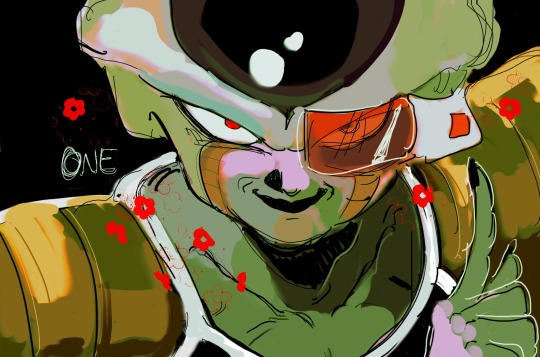
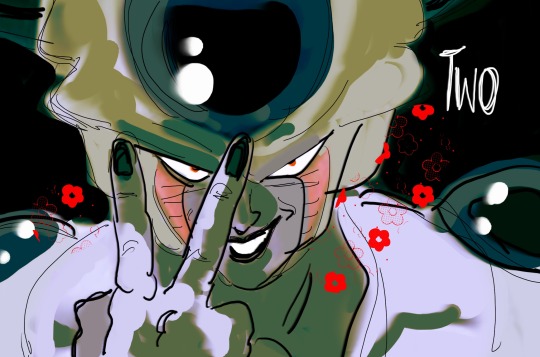

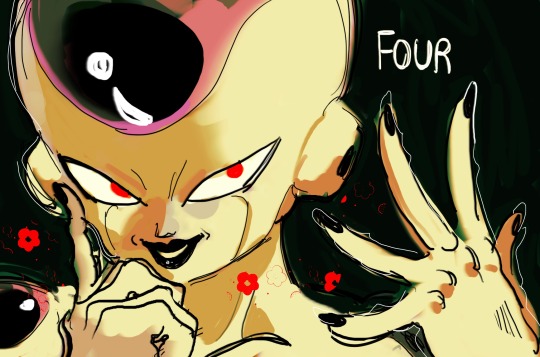
What you know as my 'first form' is meant to be a pupal form usually taken before a moult or during hibernation. It's a transitionary stage that I remained in out of necessity, as it slowed my metabolism and forced my power to remain dormant. It's commonly associated with children and the elderly, which was great fun to find out when I was in my teens and not allowed to leave it, but I digress.
The 'second' is...well, to put it gently, it's more bark than bite. My father preferred it only because 1) he liked to puff up his chest for the sake of his own ego and 2) he wasn't strong enough to create his own signature form. He insisted it inspired fear and respect among his subjects, but to me it just made him look desperate. It was embarrassing. (Also, apparently in times of old it was used in courtship, which given that context is quite funny .)
The 'third' is an evolutionary holdover from our days as semiaquatic predators, built for echolocation and pursuit. Isn't that fascinating? Imagine me swimming at full tilt to tear you to pieces. Ooh, very nice.
And the 'fourth', my true form, is the body in which I was born. A jack of all trades, if you will--or clay, to be moulded into whatever shape I please.
All this to say that our transformations are largely a matter of personal taste and aesthetic preference. My brother's an idiot tryhard whose diet consists mostly of protein shakes and broken dreams, so he decided to make himself look like the damned Space Terminator. That's not my problem.
#long response#img response#text response#T-L-D-R; My father was a moron and my brother took after him.
40 notes
·
View notes
Text
so i recently got a job rearing butterflies and it goes without saying that i am not at all grossed out by bugs and im fine with touching them and dealing with frass and everything no problem
but
oh my god
(disgusting bug gore under the cut)
i DO NOT LIKE when they melt. its disgusting its horrible i hate it. i hate when they melt and i hate when pupae rot and break open and start oozing
disgusting disgusting disgusting and i have (usually lowkey sometimes very highkey) contamination OCD so im freaking out over these melted caterpillars my coworker training me said i could clean up the workspace when were done going through the bins but we dont know why they melt and i smeared some slime that used to be caterpillars where i was working so i had to pour peroxide over it all before i could resume working and still changed where i was working. horrible
if anyone has any idea why theyre melting please feel free to share. it seems sulphurs from one specific plant get it the worst, thats what i was dealing with today. but monarchs seem more susceptible to melting than some others but not nearly as much as the sulphurs
i also have always hated how uncertain the pupal stage is. as a kid my teacher raised butterflies sometimes and there were a lot of monarchs in my yard and i have many unpleasant chrysalis memories and now ill get to have even more
at least when i brushed against a pupa today and got wet with slime that was because it just eclosed and the butterfly was alive and flying and that was just residue from the miracle of metamorphosis. but then i was removing dead ones and multiple broke and black sludge came out. hate that. and they stink
honestly butterfly chrysalises are a little gross to me just because i dont like how they die. i feel similarly about turtles. like im so creeped out by them getting sick hurt or dying that i just get creeped out by them. it took me a bit to get comfortable holding the chrysalises because i was sure i was going to break them. i dont like when they wiggle because i wont want anything bad to happen
20 notes
·
View notes
Text
fuck it we ball. my thoughts on angels ft some discussion of gabriel in particular because i have got to talk about his bug ass at least a little
Angels, moreso greater and supreme angels, are basically weird bugs (or weird crustaceans sometimes, but generally have more in common with earthly insects), though it's hard to tell in their most common state, which despite what you may be led to believe is not their natural state.
The most common form of angels, armored humanoids with halos and wings, are more along the lines of a sort of "cultivated" creature, the divine Light that gives them much of their power channels their being into something far more outwardly controlled than how they otherwise would appear; their armor is actually more akin to an exoskeleton (though still metallic rather than chitinous), and some appear to have structures on their helmets that in reality are fused mandibles, among other things. If one were to dissect an angel in this state and study the findings, you would find their anatomy to resemble a strange and esoteric insect, containing imaginal discs that at first appear to be vestigial.
These discs, however, are not vestigial, rather dormant. 'Fallen' angels are those who have reverted back into their natural state, developing more arthropod-esque features such as antennae and extra limbs and appendages. Due to their divine nature, their bodies retain a small amount of innate Light that prevents them from dying outright (a fact few in Heaven are actually aware of), allowing their halos and wings to persist, though they may warp into horns and other structures or outright break apart at this point.
The process by which angels "fall" is actually more of a semi-gradual metamorphosis that lacks a pupal stage, and this period often tends to be very stressful and/or painful, leading to the development of many initially "monstrous" features, though with time and opportunity to de-stress, these can heal and smooth themselves out into more natural traits. Fallen angels, if given long enough, start to lose their more 'purposeful' appearance, losing some the details that turn their carapace into a more convincing suit of armor, gaining a sort of 'bug fluff', or developing drives to sleep and eat, amongst many other things. They may also grow larger and stronger than their still-holy kin, though nobody up in Heaven pays enough attention to the fallen to know this for sure.
Fallen angels also tend to be somewhat colder than their holy peers, though a deep outlier to this is Gabriel, who is bordering on freezing due to a small (not really) incident involving the frozen lake that comprises most of Treachery. He never really warmed back up after that.
Gabriel himself resembles something vaguely akin to a cicada. or a mantis. or a wasp. or a scorpion. vaguely, you see. turns out i dont aactually feel like describing him in detail but you can look at his bug ass here. Some of the details that aren't so apparent include the fact that under the antenna (the 'wings' covering his face) the front of his helmet is broken off, revealing no actual 'face' within but exposing a somewhat-spidery arrangement of compound eyes, and the 'spike' of his helmet is split into wasp-like mandibles. His secondary pair of limbs also stem more from his midsection but i forgot to specify that lmao uh i had less to say about him specifically than i thought. post.
67 notes
·
View notes
Note
(TW unsanitary + animal abuse + possible animal death, feel free to ignore this ask if it's too gruesome for your blog, sorry!) do butterflies and moths poop out meconium? there's this tiktok video that was making rounds on reddit a while ago promoting "butterfly milk", where the tiktok OP showed themself making it by "helping a moth out of its cocoon" and squeezing its abdomen over a jar of water until a cream-colored liquid came out.
obviously it's not milk, and i don't really want to post the video so the creator doesn't get any more views, but do you have any clue on what that liquid actually was? the top comment on reddit claimed it was a form of meconium aka a baby's first stool, and that lepidopteran meconium is made out of the remains of its larval stage, but i can't find a source on that so i'm taking that with a huge grain of salt.
would any of this have harmed the moth? would it be able to survive being presumably pulled out of the chrysalid too early?
Yikes! "Helping" a butterfly or moth out of its pupa is a bad idea, and so is squeezing the abdomen directly after it emerges. The chances of doing more harm than good are extremely high, especially if it's not ready to emerge yet. There's a lot that needs to happen immediately after emerging and forcing it or interrupting it is a very bad idea - it could end up deformed or dead - it might be fine, if it was very close to emerging anyway, but there's literally no reason to risk it.
The only exception to "helping" one emerge is (in captive raised specimens only) very gently removing any pieces of stuck pupal casing if they can't remove it themselves, but obviously give it a chance to do it itself first. I have only had to do this once with one of my sphinx moths - she had part of the pupal case stuck to her proboscis.
Yes, the liquid they excrete after emerging is called meconium and yes it's the waste product left behind from metamorphosis. I can't think of a good reason to collect the meconium, let alone forcing it out of the newly emerged bug. They'll easily expel it all on their own.
Referring to the meconium as "milk" and implying that they need help emerging is really bizarre.
140 notes
·
View notes